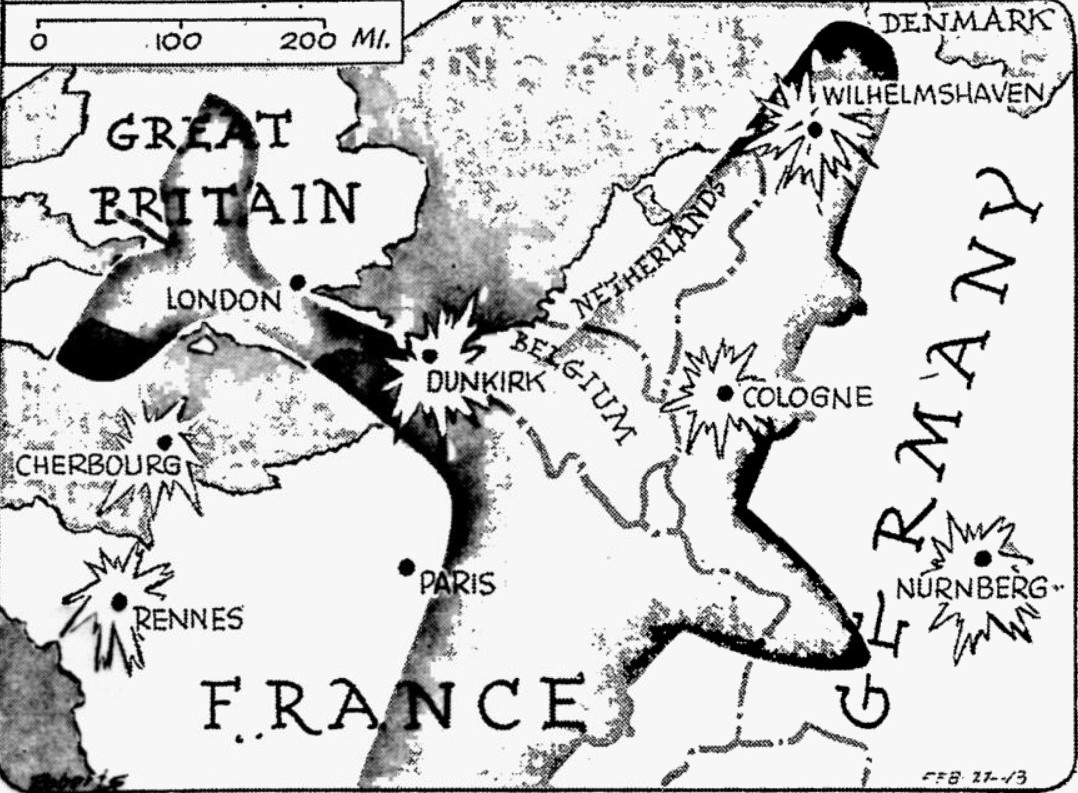Völkischer Beobachter (February 27, 1943)
Drei Sondermeldungen in vier Tagen –
Dreißig Schiffe aus einem Geleitzug torpediert
Sechs Tage lang und über 2500 Kilometer ging die Verfolgungsschlacht
Berlin, 26. Februar –
Die dritte Sondermeldung in vier Tagen über die Erfolge deutscher Unterseeboote, die am Freitagabend über den Großdeutschen Rundfunk ging und die Versenkung von neuerlich 17 Schiffen mit insgesamt 107.800 BRT. meldete, brachte die seit Wochenbeginn mitgeteilten Versenkungsergebnisse der Unterseeboote auf 49 Frachter und Tanker sowie 4 Transportsegler mit zusammen 315.000 BRT. Dazu kommen 3 Kriegsfahrzeuge des Geleitdienstes. Der Aderlaß für die englische und die USA.-Handelsflotte ist aber noch größer, da von den 9 als schwer beschädigt gemeldeten wetteren Dampfern nur wenige einen Hafen erreicht haben werden. Besonders bemerkenswert aber ist die Mitteilung aus der Befehlsstelle des Großadmirals Dönitz, daß dabei allein aus einem einzigen Geleitzug, der von England nach Nordamerika strebte, 23 Frachter und Tanker versenkt und 7 weitere beschädigt worden sind, wodurch das Großgeleit bis auf kleine Überbleibsel vernichtet werden konnte. Dies ist die sechstägige Geleitzugschlacht, die in der Sondermeldung erwähnt ist und in ihrer Härte und ihrem Ausmaß zu den besonders hervorragenden Leistungen der Unterseebootwaffe der deutschen Kriegsmarine in ihrer an Erfolgen so reichen ozeanischen Seekriegführung gehört.
Über eine Strecke von 2500 Kilometer Länge (etwa Paris bis Moskau), von der ersten Sichtmeldung 600 Seemeilen südwestlich Irlands bis an die neblige Neufundlandbank, hat diese Geleitzugschlacht von den Mittagsstunden des 20. Februar bis in die Morgenstunden des 25. Februar Tag und Nacht getobt. Sie wurde geschlagen, nachdem sich die Stürme der ersten Februarwochen zeitweise gelegt hatten. In der Sturmperiode hatten unsere Unterseeboote nicht geruht, sondern sich trotz des schlechten Wetters zu einem neuen Schlag bereit gemacht, bei dem sich ihre gefürchtete Rudeltaktik aufs neue bewährt hat. Am 21. Februar erfolgte aus dem westwärts steuernden Geleit die erste Versenkung des abgesprengten Tankers „Stigstad.“ Am 22. Februar wurden aus dem stark gesicherten und abwehrbereiten Geleit die ersten drei Tanker torpediert und dann folgten, während noch mehr Unterseeboote auf den feindlichen Schiffsverband angesetzt wurden, Schlag auf Schlag die weiteren Versenkungen. Obwohl der Wind zeitweise wieder bis zur Stärke 7 auffrischte und mehrfach schlechte Sicht und Nebel die Angriffe behinderten, wurden insgesamt 30 Schiffe torpediert, so daß nur ein geringer Rest noch die Gewässer von Neufundland erreichte. Dieser Vernichtungssieg über ein englisch-amerikanisches Großgeleit ist errungen worden, obwohl die feindliche Gegenwehr sehr heftig war, obwohl der Geleitzug weit ausholende Ausweichbewegungen machte und sich zeitweise in mehrere kleinere Gruppen aufteilte. Die Zusammenfassung des feindlichen Schiffsverkehrs in Geleitzüge bietet den deutschen Unterseebooten Massenziele.
Erfolge gegen starke Abwehrerzielt
Aber die Erfolge fallen ihnen deshalb nicht etwa in den Schoß. In der englischen und USA.-Presse möchte man es freilich so darstellen, als ob die Erfolge der deutschen Unterseeboote nur einem Mangel an Geleitkriegsschiffen zuzuschreiben sind. Die USA.-Zeitschrift Times hat diese Agitation zur Begründung der schweren Schiffsverluste soweit übertrieben, daß sie schrieb, große Geleitzüge würden oft nur von einem einzigen Zerstörer begleitet, der nicht überall zugleich sein könnte. So einfach haben es die deutschen Unterseeboote in Wirklichkeit durchaus nicht, sondern die Versenkungen feindlicher Frachter und Tanker erfolgen in zähestem Ringen gegen die starke Sicherung der feindlichen Geleitzüge. Zu dieser Sicherung gehören außer Zerstörern, Korvetten und ähnlichen Geleitzugfahrzeugen auch zahlreiche feindliche Flugzeuge. Die Engländer und Amerikaner sind bestrebt, jedem Geleitzug auf einzelnen Dampfern oder auf Hilfsflugzeugträgern Bordflugzeuge zu seiner Sicherung mitzugeben. Dazu kommen die Flugboote, zum Beispiel vom Typ „Catalina,“ und die viermotorigen Fernbomber vom Typ „Liberator,“ die dadurch einer Verwendung gegen Landziele entzogen werden. Gegen ein derartiges Aufgebot von See- und Luftstreitkräften also müssen sich die deutschen Unterseeboote durchsetzen. Ihre Siege in den Geleitzugschlachten werden dadurch nur um so wertvoller und bedeutsamer. Sie zeugen von dem unbeugsamen Angriffswillen und dem taktischen Geschick der Unterseebootkommandanten und von der Zähigkeit ihrer Besatzungen, aber auch von der Güte der Boote, Motoren und Waffen aus deutschen Werften und Rüstungswerken, die sich im Gefecht, im Wasserbombenhagel und in schwerer See ständig zu erproben haben.
Außer in der Geleitzugschlacht im Nordatlantik sind auch weiter südlich im Atlantik und im Mittelmeer neue Erfolge gegen feindliche Geleitzüge, insbesondere des Nachschubs für Nordafrika, erzielt worden, der durch die Ereignisse in Tunis für unsere Gegner besonders dringlich geworden ist. Ferner werden Versenkungen aus dem Seeraum von Südafrika gemeldet, wo sich ebenfalls die feindliche Abwehr verstärkt hat. Aus Kapstadt wurde dieser Tage in einer Reuter-Meldung berichtet, daß zahlreiche Sicherungsfahrzauge in südafrikanischen Gewässern neu eingesetzt worden seien. Dies kennzeichnet die Zwangslage, in die die feindliche Seekriegführung durch die weiträumigen deutschen Unterseebootoperationen versetzt worden ist. Selbst in den entferntesten Seegebieten müssen die englische und die USA.-Kriegsmarine Abwehrkräfte bereitstellen. Das Geleitzugsystem ist längst südlich über den Äquator hinaus ausgedehnt worden, was auch dort eine Verlangsamung und Behinderung des Seeverkehrs bedeutet. Trotz dieser gesteigerten Abwehr und trotz der großen Materialaufwendungen des Gegners aber können die Erfolge der deutschen Unterseeboote nicht aufgehalten werden.
EG

